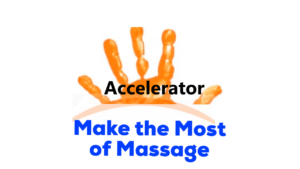What’s my simple secret to better pain relief massage therapy?
Find the client’s pain areas before she gets on the table.
I told you that it was simple. But my simple tip packs a big therapeutic punch.
First, I’m going to explain how I find the client’s pain areas pre-massage.
How to Find Pain Areas Pre-Massage
During the intake, I talk to my client about her pain areas.
Then I ask her if I can palpate those areas right then and there before she gets on the table.
It’s at this time that I find the exact locations of the pain areas.
Then I make a mental note and write pain location information in my therapy notes before I start the massage.
Now I’m ready to kick the crap out of some pain…well, you know what I mean…
Onto the why.
Why Palpate Pain Areas Pre-Massage
Understanding where to go before a client gets on the table is therapeutically huge.
For one, when you find the pain spots you’re showing your client that you’ve listened to her.
Secondly, you’re also acknowledging her pain.
That’s a whole lot of care and concern coming her way.
Care and concern reduces a client’s treatment-related stress.
1. Reduce Treatment-Related Stress
Speaking of stress, remember the last time you went to the doctor?
Did you feel at ease?
Yeah, right…
In fact, you probably were a little stressed out.
One reason why you may have felt stressed out is because in the US medical system, pain is primarily viewed as a function of tissue damage (biomedical view), and the psychological and sociological components of pain are ignored, resulting in the patient feeling alienated and stressed.
I explain the biomedical view in greater detail in 4 Lesson On Chronic Pain–Notes From a Mountain Guide.
Don’t biomedical-ize your clients before they get on the table.
The MRI and X-ray are the appropriate tools to help figure out pain issues.
Our hands are the appropriate tools to reduce treatment-related stress.
And when you use your hands (ears and words) to reduce stress before the massage, you’re client is more likely to believe that you’re the person to get the job done.
2. Gain the Client’s Confidence
When I first started doing pain relief massage I never looked for pain spots pre-massage.
Instead I let my bumbling fingers poke and prod until my client gave me a clue like: Ouch!
In retrospect, I am confident that my clients had little to no confidence in my ability to find their pain, let alone relieve their pain, which brings us to the how-much-pressure question.
Palpating a pain spot before the client gets on the table is also the perfect time to experiment with how much pressure you want to apply to the pain spot.
3. Find the Therapeutic Pressure
If you accidentally press too hard pre-massage and get a grimace from the client, that’s okay.
At least now you’ll know the pressure parameters to work within when you start the massage.
Pre-massage palpation can also help you rule out areas that are inflamed and shouldn’t be massaged.
One more thing.
At the end of a heavy day your memory may get foggy (like mine does). But if it does, pre-massage palpation will you help you…
4. Remember Where All the Pain Areas Are
Going through a pre-massage palpation protocol makes the pain spots stick in my memory.
And I don’t find myself in the embarrassing situation of missing a pain area I should have worked.
Oh, sometimes knowing where a pain spot is pre-massage doesn’t guarantee that you’ll find it when the client gets on the table.
Where’d the Pain Spots Go?
Here’s how I find a “lost” pain spot: I create contrast.
First, put your fingers or thumbs around the area where you think the pain spot is.
Press down and move back and forth over that area.
If you don’t feel anything, press deeper and make your back-and-forth stroke longer and faster.
If you’re still having trouble, close your eyes so that your focus is in your fingers.
Stress Be Gone!
I’m a pre-massage palpation junkie because my stress is reduced when I find the pain areas before the client gets on the table.
When I do the client relaxes and I gain competency points.
I also find the starting point for the appropriate therapeutic pressure and I burn the pain areas into my memory.
Here are my quick steps for finding pain spots pre-massage.
Pain Relief Massage Therapy: Steps for Finding Pain Spots
During the intake…
(1) ask the client if you can palpate his pain spots,
(2) then locate pain spots on the client,
(3) test out pressure, and
(4) recall and write down where the pain areas are.
Like I said, it’s a simple thing.
But the therapeutic bang is big.
Does your pain relief massage therapy practice have a website?
 My website history reads like a Stephen King horror novel.
My website history reads like a Stephen King horror novel.
And my massage practice suffered because of it.
Don’t be me then.
Here’s how to fix website woes: How to Build a Website Fast and Cheap.
Need more help?
Get my latest everything weekly.
Just sign up below. (It’s free:-)







Comments on this entry are closed.